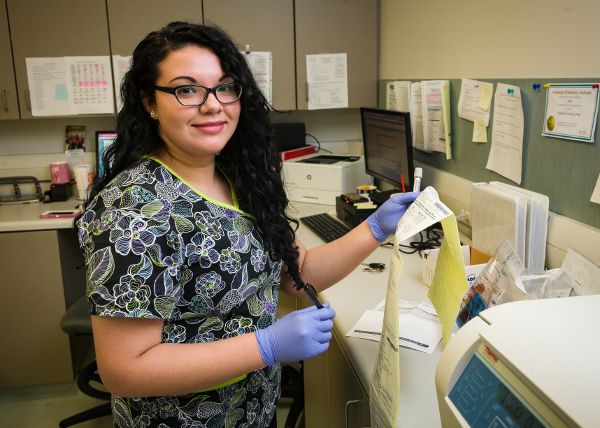Overview
Pancreatic cancer begins when cells in the pancreas start to grow uncontrollably. A tumor can form when more cancer cells develop, and it can spread to other areas of the body. As it grows and spreads, the cancer becomes more advanced. Some abnormal growths of the pancreas are benign, or not cancerous, and others are pre-cancers, meaning they might develop into cancer if untreated.
The pancreas is an organ located behind the stomach. It produces digestive enzymes and hormones important to metabolic regulation, including the blood sugar regulators insulin and glucagon.
Types of pancreatic cancer include:
- Exocrine pancreatic cancers
- Pancreatic adenocarcinoma
- Exocrine pancreatic cancers are most common, and 95% of those are adenocarcinomas
- Adenosquamous carcinoma
- Squamous cell carcinoma
- Signet ring cell carcinoma
- Undifferentiated carcinoma
- Pancreatic adenocarcinoma
- Pancreatic endocrine tumors or pancreatic neuroendocrine tumors (NETs), which may be benign or malignant (cancerous), and are rare (less than 5% of pancreatic cancer cases)
- Functioning NETs
- Non-functioning NETs
- Carcinoid tumors
Ampullary cancer, which occurs in the part of the body where the bile duct and pancreatic duct meet the small intestine, is not technically a pancreatic cancer, but is treated similarly.
Symptoms
It is important to note that the symptoms listed below can be caused by a number of other non-cancerous causes, but it is important to be checked by a medical professional with these symptoms.
Symptoms of exocrine pancreatic cancer may include:
- Jaundice, which may cause dark urine, light-colored or greasy stool, or itchy skin
- Abdominal or back pain
- Unintentional weight loss, poor appetite
- Nausea and vomiting
- Enlargement of the gallbladder or liver
- Blood clots, often in the leg
- Fatty tissue abnormalities (such as uneven texture)
- Diabetes
Pancreatic neuroendocrine tumors may cause many different symptoms based on the hormones produced in excess by the tumor. You can learn more about the different types of pancreatic NETs and their associated signs and symptoms by visiting the American Cancer Society website.
Risk Factors
Pancreatic cancer risk for smokers is double that of non-smokers, and 20-30% of pancreatic cancer cases are thought to be associated with smoking. Other types of tobacco use (cigars, pipes, and smokeless products) also increase risk.
Obesity is also a significant risk factor: obese people are about 20% more likely to develop pancreatic cancer than those at a healthy weight. Extra weight around the waist (abdominal fat) may increase risk even for those whose body weight is closer to the normal range.
Occupations in the dry cleaning and metal working industries may involve significant exposure to chemicals which may increase pancreatic cancer risk.
Pancreatic cancer risk increases with age, with about two-thirds of cases occurring in patients over 65. Men are more likely than women to develop the disease, but this is thought to be due in part to higher rates of tobacco use by men, as a recent decrease in the difference in risk correlates with a decrease in the difference in tobacco use by men and women. African-Americans are at slightly higher risk of pancreatic cancer, but this, too, may be explained by a difference in other risk factors (rates of diabetes and obesity, etc.).
Certain conditions can increase the risk of developing pancreatic cancer, including:
- Diabetes, especially type 2
- Chronic pancreatitis
- Cirrhosis of the liver
- Stomach infections (with H. pylori)
A family history of pancreatic cancer as well as certain other genetic factors may contribute to pancreatic cancer. These genetic factors may include:
- BRCA1 or BRCA2 gene mutation
- Familial atypical multiple mole melanoma (FAMMM) syndrome (p16/CDKN2A gene mutation)
- Familial pancreatitis (often associated with a PRSS1 gene mutation)
- Lynch syndrome or hereditary non-polyposis colorectal cancer (HNPCC)
- Peutz-Jeghers syndrome
- Von Hippel-Lindau syndrome
- Neurofibromatosis, type 1
- Multiple endocrine neoplasia, type I (MEN1)
Prevention
While some risk factors, such as age, gender, and race cannot be controlled, there may be some things you can do to lower your risk of pancreatic cancer:
- Refrain from or stop smoking
- Maintain a healthy weight
- Limit alcohol use. While a direct link between alcohol and pancreatic cancer has not been confirmed by research, secondary conditions of heavy alcohol use, including pancreatitis and cirrhosis, are known risk factors.
- Limit exposure to known carcinogenic chemicals in the workplace (find a list and more information at the American Cancer Society’s website)
Diagnosis
If pancreatic cancer is suspected, a detailed medical history and physical exam will be performed. Your doctor will ask questions about your risk factors and family history. The physical exam will include a close examination of the abdomen.
A biopsy of pancreatic tissue is usually needed to confirm a diagnosis of pancreatic cancer, and may be done surgically, endoscopically, or through the skin via a fine needle aspiration. Imaging tests including CT, MRI, ultrasound, cholangiopancreatography, somatostatin receptor scintigraphy (SRS), PET, and angiography may be used throughout diagnosis and treatment.
Other tests may be used in addition to the diagnostic tools discussed above. These include a variety of blood tests used to determine the level of functioning of the pancreas and other organs, look for tumor markers, and evaluate other symptoms.
Treatment
The treatment plan will depend on the stage of the cancer, as well as other factors. Our doctors will work closely with you and your family determine the best treatment plan for you. Options for treatment could include:
- Surgery
- Ablation or embolization treatments
- Radiation therapy
- Chemotherapy
Your doctor may decide more than one of these treatment options will be in your best interest.







